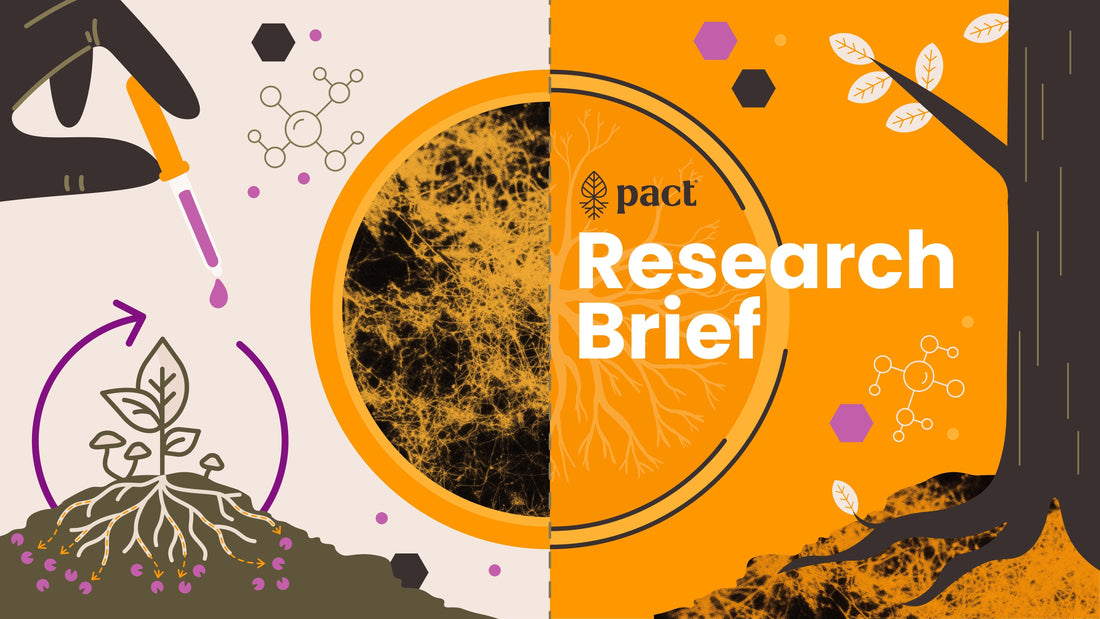
Bad Fungi Versus Good Fungi
Share
Parasitic Fungi Versus Saprotrophic Fungi
The Kingdom of Fungi is estimated to contain millions of different species, filling a wide range of ecological niches, or roles. There are “good” fungi and “bad” fungi. Parasitic fungi, like other types of fungi, produce extracellular enzymes to digest their food. However, parasitic fungi feed on living plants and animals, causing diseases, reduced biological function, and even death. Parasitic fungi infect living hosts and sap them of their nutrients. Fungi can be zoo-pathogenic (infecting animals) or phyto-pathogenic (infecting plants).
Saprotrophs, the “good” fungi, do not infect and harm living organisms. Decomposer fungi like S. rugosoannulata digest already dead or decaying matter, providing many ecological benefits. The likelihood for S. rugosoannulata to become parasitic towards plants or animals is practically zero. Saprotrophic mycelia are actually frequently working with plants to exchange nutrients and water, which indirectly benefits animals and the ecosystem as a whole.
Invasive Versus Non-Native Species
All invasive species are non-native, but not all non-native species become invasive. “Non-native” species refer to organisms that have been introduced to an ecosystem where they do not naturally occur (U.S. National Park Service 2024). This introduction can happen intentionally or unintentionally. Non-native species do not necessarily cause harm to the environment, economy, or human health and can coexist without disrupting native ecosystems (Phinney 2021).
“Invasive” species are a type of non-native species that cause significant harm to their new environment (Clinton 1999). They aggressively outcompete native species for resources, alter habitats, disrupt ecosystem functioning, and sometimes even negatively impact agriculture, human health, or infrastructure. For a species to be considered invasive, it must not only be non-native, but also exhibit traits like rapid reproduction, high adaptability, and the ability to spread widely in new environments (Convention on Biological Diversity 2024).
As defined by Executive Order 13112, an invasive species is: Non-native (or alien, exotic) to the ecosystem under consideration; and a species whose introduction causes or is likely to cause economic harm, environmental harm, or harm to human health (Clinton 1999).
According to the Convention on Biological Diversity in 2024, an invasive species has the following characteristics:
- Rapid reproduction and growth
- High dispersal ability
- Ability to adapt physiologically to new conditions
- Ability to survive on various food types
- Ability to survive in a wide range of environmental conditions
- Has successfully invaded elsewhere
- Are introduced to areas outside their natural range by human activities
Stropharia Does Not Exhibit The Characteristics Of Invasive Species
Saprotrophic fungi within the Stropharia genus have limited potential to become invasive species for a number of different reasons. These fungi decompose organic matter, particularly in nutrient-rich environments like wood chips, compost, or manure. Their reliance on specific substrates and environmental factors limits their ability to outcompete native fungi or spread uncontrollably in new environments.
In addition, Stropharia species do not generally produce long-lasting or highly resilient spores (Norros et al. 2015) (Nguyen 2018), reducing their likelihood of colonizing new ecosystems that they are not considered native to. Studies on the impact to soil communities by Stropharia rugosoannulata in Chinese forests found that, even when grown on a large-scale, the mycelium disappears if not provided with more food after a time (Gong 2018). This is consistent with findings from a field-scale study on a farm in New York, the S. rugosoannulata, introduced a year prior, did not recolonize a year later (Gallaher 2020).
S. rugosoannulata, or the Wine Cap mushroom, is widely regarded as a safe fungus, not pathogenic to other organisms. In the U.S., the Department of Health and Human Services publishes the Biosafety in Microbiological and Biomedical Laboratories which catalogs various microbes of interest (ATCC 2018). They assigned S. rugosoannulata a biosafety level of 1, meaning it presents minimal hazard to people and the environment and it is not known to consistently cause disease in healthy adults.
In addition, there exists an initiative that keeps tabs on invasive species in the European Union: The Global Register of Introduced and Invasive Species. It was created with the goal of identifying invasive alien species, controlling or eradicating these species, and putting measures in place to prevent invasive species spread. They report that S. rugosoannulata has been introduced in Austria, Poland, Czech Republic, Norway, Germany and Slovenia with no evidence of negative impact. The E.U. initiative also found that S. rugosoannulata has been introduced to countries with a range of dominant ecosystems similar to those in the U.S. and have found no evidence of invasive characteristics or negative environmental impact.
Not only is S. rugosoannulata not pathogenic, it is widely cultivated for food (Yang 2022). The Wine Cap mushroom is in the top ten mushrooms traded commercially across the world (Gong 2018). The UN’s Food and Agriculture Organization recommends it to developing countries as a mushroom for them to cultivate (De Oliveira 2020).
Summary
Stropharia rugosoannulata does not exhibit the defined characteristics of pathogenic or invasive fungi. As discussed in our Research Brief on The Characteristics Of Stropharia Rugosoannulata, the species is actually not competing with other organisms in any significant way. It is doing an essential job of converting dead or dying matter into bioavailable nutrients for other organisms. Given that its food source is never really in short supply, its genetics are tailored more around cooperation than competition.
Bibliography
-
ATCC. 2018. Safety Data Sheet for Stropharia rugosoannulata. - LINK
-
Clinton WJ. 1999. Executive Order 13112 - Invasive Species. Invasivespeciesinfo.gov. - LINK
-
Convention on Biological Diversity. 2024. What are Invasive Alien Species? - LINK
-
Gallaher. 2020. Final Report for Improving Compacted Soils with Stropharia Mushrooms. - LINK
-
Gong S, Chen C, Zhu J, Qi G, Jiang S. 2018. Effects of wine-cap Stropharia cultivation on soil nutrients and bacterial communities in forestlands of northern China. PeerJ. 6(e5741):e5741. doi:10.7717/peerj.5741. - LINK
-
Nguyen NH. 2018. Longevity of light- and dark-colored basidiospores from saprotrophic mushroom-forming fungi. Researchgate.net. - LINK
-
Norros V, Karhu E, Nordén J, Vähätalo AV, Ovaskainen O. 2015. Spore sensitivity to sunlight and freezing can restrict dispersal in wood-decay fungi. Ecol Evol. 5(16):3312–3326. doi:10.1002/ece3.1589. - LINK
-
Phinney A. 2021. Native, non-native and invasive species... what’s the difference? Lilly Center for Lakes & Streams. - LINK
-
U.S. National Park Service. 2024. What are invasive species? - invasive & non-native species. Nps.gov. - LINK
- Yang Y, Meng G, Ni S, Zhang H, Dong C. 2022. Genomic Analysis of Stropharia rugosoannulata Reveals Its Nutritional Strategy and Application Potential in Bioremediation. J Fungi (Basel). 8(2):162. doi: 10.3390/jof8020162. PMID: 35205916; PMCID: PMC8874372. - LINK
